Colombia Pipeline
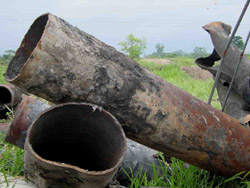 | |
|
|
Colombia: An Environment Under Siege
For almost four decades, Colombia has been wracked by a civil war among leftist rebels, right-wing paramilitary groups and the government that’s resulted in the deaths of tens of thousands of people. Judges, journalists, and politicians have often been the targets of the bombings, kidnappings and assassinations that have made this a country under seige.
The environment has also been a casualty of this conflict. Colombia is a major oil-producing country; it is the U.S’s ninth leading supplier. But, in the last twenty years, millions of barrels of oil have ended up, not at a port, but in Colombia’s soil and water. That’s because the two main rebel groups, FARC, and ELN, have been blowing up pipelines that carry oil for foreign companies. The result has been that almost 3 million barrels of oil, which amounts to 14 Exxon Valdezes, have ended up polluting soil and water. Their main target is a tract jointly operated by the Colombia state oil company and U.S-based Occidental Petroleum. This pipeline transports 100-thousand barrels of oil a day. That is, when it’s up and running.
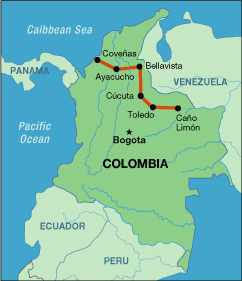 | |
|
|
Last year alone, attacks shut down this pipeline more than 2/3 of the time, costing the country $430 million dollars in oil revenue.
A few months ago, the Bush Administration ordered special forces into Colombia. They’re there to train the country’s army to defend the pipeline, but the attacks continue.
In the first of a two-part series on Colombia’s civil war and the environment, reporter Angela Swafford traveled to her homeland to document the destruction. She sent us back this reporters notebook.
![]()
![]() Everything surrounding the oil industry in Colombia has an inherent element of danger. Yet, people working in this environment are so used to it, they take things with a coolness that is almost unnerving to any outsider. [listen: realaudio/mp3]
Everything surrounding the oil industry in Colombia has an inherent element of danger. Yet, people working in this environment are so used to it, they take things with a coolness that is almost unnerving to any outsider. [listen: realaudio/mp3]
Security at the National Control Center of Ecopetrol, Colombia’s state oil company in Bogotá, is tighter than ever during my visit, because the government has decided to up the ante against the country’s two main guerrilla armies, Fuerzas Armadas Revolucionarias de Colombia, FARC, and Ejército de Liberación Nacional, ELN.

As everywhere else here, I have to explain again and again what my digital audio tape recorder is and what I am using it for. In some cases, I am asked to give a demo… No matter how many letters of invitation and ID’s I carry, and no matter who is escorting me.
Reaching the nervous system at the Control Center, on the penthouse of a massive concrete building, means going through more than one set of bullet-proof crystal doors. They lead to a room filled with people checking monitors that control the oil pressure of the several kilometers worth of pipelines that run throughout the country. Constant alarms announce pressure drops in diverse oil and gasoline pipelines. About half of these alarm calls mean someone is stealing the crude or any of the other oil-related products. The rest means a guerrilla attack has blasted the pipeline. Last year alone, one pipe was dynamited over 300 times. [listen: realaudio/mp3] As a result, engineers here don’t get anxious anymore every time they hear an alarm. For an outsider, who would expect someone yelling “there’s been an explosion on Pipe X!” The sedated atmosphere is something surreal, a work environment where voices never raise above normal conversation, and excitement is replaced by a methodic and professional set of procedures.
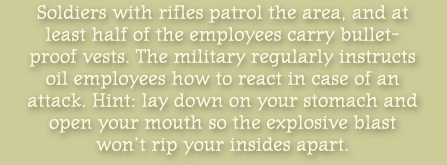
The real nerves of steel, however, are needed when you work in the field. Oil pipe repair crews, helicopter pilots, maintenance chiefs, even biologists, must risk their lives routinely as they patrol the lines, especially the one called Caño Limón-Coveñas, which has traditionally been the pet target from FARC and ELN, attacked over 900 times in its 16-year history.
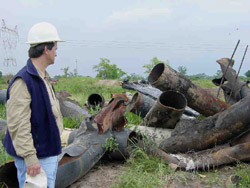 | |
|
|
In order to repair a blasted tube, the Army needs to come in first and secure the area. Even then, you are in serious danger from land mines, or of being shot at during the chopper landing, when you are at your most vulnerable. During my tour of the infamous Caño Limón-Coveñas pipeline, which follows the Venezuela border, we fly at 3,000 feet high, an altitude that is safe for land-to-air fire. But when it’s time to land, the pilot performs a series of radical maneuvers designed to make us an elusive target, which include wildly swinging the aircraft from side to side. The first time, it catches me by surprise, and of course it coincides with the moment I am changing batteries, which fly in all directions inside the cockpit. [listen: realaudio/mp3]

Upon our arrival to Banadía Pumping Station, located next to the buried pipeline in the middle of wilderness, I am escorted to an office. My recorder is examined, my papers are closely scrutinized, and I am told the rules of my visit.
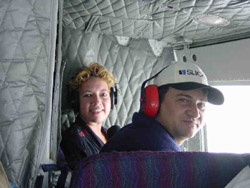 |
|
|
Under no circumstances am I to wander alone anywhere, much less out of the station and into the field. There is no way we can venture 10 miles out to see a huge section of the pipeline that was blasted away two months ago, leaving a large oil patch on the grass. I ask why. Their answer, “two people were shot last night by FARC guerrillas.” Instead, they promise to take me to another pipeline section, closer to the station, that has also been blasted earlier. “But worry not, you can see where the oil was spilled all right,” they say. “That is definitely not a problem around here”.
 Before I get to do anything, though, I must take the tour of the bunkers of the station: that way I will know exactly where to duck in, if and when the siren announcing guerrilla attacks, or guerrilla presence in the area, goes off. [listen: realaudio/mp3] I look around me. In any other country, this would be just a pumping station. A place where sluggish oil gets a little “push” down the tube. But Banadía station has become a mid-points logistics and command center to respond to terrorist attacks on the oil infrastructure. Huge warehouses contain hundreds of thousands of dollars-worth of equipment used to scoop up spilled oil from diverse environments, and repair broken tubes.
Before I get to do anything, though, I must take the tour of the bunkers of the station: that way I will know exactly where to duck in, if and when the siren announcing guerrilla attacks, or guerrilla presence in the area, goes off. [listen: realaudio/mp3] I look around me. In any other country, this would be just a pumping station. A place where sluggish oil gets a little “push” down the tube. But Banadía station has become a mid-points logistics and command center to respond to terrorist attacks on the oil infrastructure. Huge warehouses contain hundreds of thousands of dollars-worth of equipment used to scoop up spilled oil from diverse environments, and repair broken tubes.
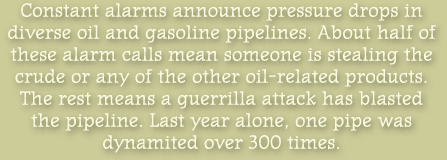
Next to the station are deep “pools” lined with thick plastic sheets, containing the scooped up crude. There are mounds of blasted, burnt pipes in a grass field on one side, and rows of new ones neatly stacked on the other. A gigantic Russian cargo chopper lifts two sections of new pipeline to be taken some 50 miles to the north, the site of the latest attack. I want to go with them and see the repairs. The answer is a big “no.”
Soldiers with rifles patrol the area, and at least half of the employees carry bullet-proof vests. The military regularly instructs oil employees how to react in case of an attack. Hint: lay down on your stomach and open your mouth so the explosive blast won’t rip your insides apart.
But I go inside the dining room, which doubles as TV room, and notice people carry on normally. Some play cards, some watch the news. Someone is getting married next week in Bogotá, and plans are being laid out for a surprise party. There is talk of movies, money, families. In the meantime, my DAT recorder breaks down. Something is wrong (as is usual for me in the field) with the battery holder. Immediately four people converge to fix it with an ingenuity that is typically Colombian. It now looks like a war veteran, full of bandages and stories to tell.
Suddenly, it dawns on me that life in this pumping station mirrors life in any other city in the Colombia I grew up in: everything looks normal inside. It even “feels” normal. You get used to talking about violence, you watch it every day on TV, it is always far away from you, “there,” in the countryside. You even joke about it. Yet, deep down you know there is a very real threat out there. One I could have easily seen today and was fortunate not to have experienced.
[listen to this story: realaudio/mp3]
Related Links:
– Colombia: War Without End
– Colombia: The Pipeline War
 | |
|
|
Colombia Narcos and the Environment
![]()
![]()
![]() Colombia is a country rich in biodiversity. Indeed, no other nation can claim more species of birds and amphibians. And Colombia ranks among the world’s top countries in abundance of flowering plants. But the country’s 40-year-old civil war and the drug industry have taken a toll on the natural world.
Colombia is a country rich in biodiversity. Indeed, no other nation can claim more species of birds and amphibians. And Colombia ranks among the world’s top countries in abundance of flowering plants. But the country’s 40-year-old civil war and the drug industry have taken a toll on the natural world.
The Colombian government estimates that two and a half million acres of forest have been cut down in the last decade to make room for coca, and lately for poppy, the raw material used to make heroin. Add to that the damage done by the chemicals used to grow and process these crops.
In the 2nd of our two-part series on Colombia and the environment, reporter Angela Swafford traveled deep into rebel-held territory. She has this first-hand view of the damage to Colombia’s Amazonian forest.
Click here to listen to this story.
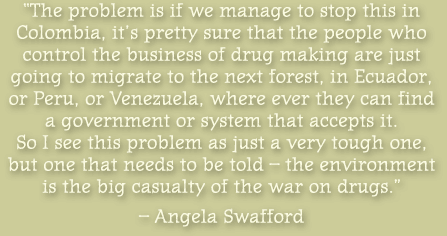
 |
For a slideshow of reporter Angela Swafford’s trip, click here.
Effects of Defoliation on Colombia’s Environment
![]()
![]()
![]() The cultivation and processing of coca in Colombia has caused temendous environmental devastation. But controversy surrounds one of the main methods used to stamp out the coca trade. The country’s herbicide spraying program – an effort funded by the U.S. – has been criticized for causing its own environmental problems.
The cultivation and processing of coca in Colombia has caused temendous environmental devastation. But controversy surrounds one of the main methods used to stamp out the coca trade. The country’s herbicide spraying program – an effort funded by the U.S. – has been criticized for causing its own environmental problems.
Some legitimate farmers say their crops are mistakenly destroyed by the fumigation effort. And some worry about the effects the chemicals may have on people and their livestock. David Adams is the Latin America correspondent for the St. Petersburg Times. He’s traveled through the region targeted by the government sprayers, and he spoke to Living on Earth about this spraying program and about the controversy surrounding it. Click here to listen to this interview. Adams begins by answering the question of what chemicals are used to defoliate the coca crops.
Some of David Adams’s stories can be found on the St. Petersburg Time’s web site by searching the archives at www.sptimes.com. Last year he was awarded Columbia University’s Graduate School of Journalism Maria Moors Cabot prize for outstanding reporting on Latin America.
Back to the series and features homepage
Living on Earth wants to hear from you!
Living on Earth
62 Calef Highway, Suite 212
Lee, NH 03861
Telephone: 617-287-4121
E-mail: comments@loe.org
Newsletter [Click here]
Donate to Living on Earth!
Living on Earth is an independent media program and relies entirely on contributions from listeners and institutions supporting public service. Please donate now to preserve an independent environmental voice.
NewsletterLiving on Earth offers a weekly delivery of the show's rundown to your mailbox. Sign up for our newsletter today!
 Sailors For The Sea: Be the change you want to sea.
Sailors For The Sea: Be the change you want to sea.
 The Grantham Foundation for the Protection of the Environment: Committed to protecting and improving the health of the global environment.
The Grantham Foundation for the Protection of the Environment: Committed to protecting and improving the health of the global environment.
 Contribute to Living on Earth and receive, as our gift to you, an archival print of one of Mark Seth Lender's extraordinary wildlife photographs. Follow the link to see Mark's current collection of photographs.
Contribute to Living on Earth and receive, as our gift to you, an archival print of one of Mark Seth Lender's extraordinary wildlife photographs. Follow the link to see Mark's current collection of photographs.
 Buy a signed copy of Mark Seth Lender's book Smeagull the Seagull & support Living on Earth
Buy a signed copy of Mark Seth Lender's book Smeagull the Seagull & support Living on Earth

